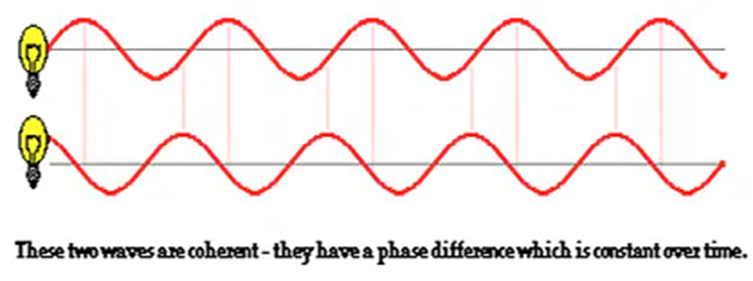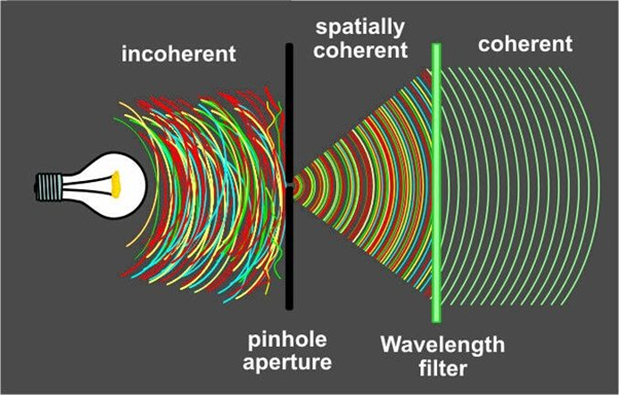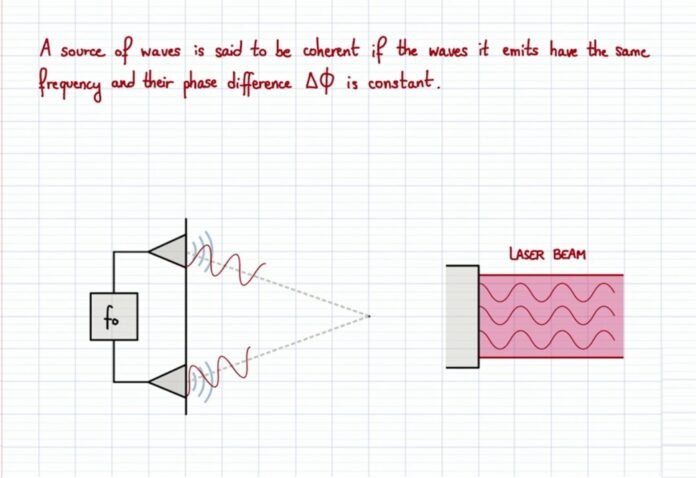Coherence
Coherence is a fixed relationship between the phase of light waves in a beam of radiation of a single frequency and two beams of light are coherent waves when the phase difference between their waves is constant whereas they are noncoherent if there is a changing or random phase relationship. In 1939 there was a turning point in the development of coherence theory as Fritz Zernike published a paper in which he introduced a precise measure of spatial coherence in light fluctuations at two points in an optical field, the so-called mutual intensity, and also its normalized version, the degree of coherence. There are two types of coherence:
Temporal coherence and spatial coherence.
Temporal coherence is a measure of the average relationship between the value of a light wave and itself making a delay of τ, at any considerable pair of times whereas spatial coherence can be described as the ability of two points in space of a wave (p1 and p2) that will interfere.
Coherent sources
Depending upon the type of frequency and wavelength formed, light sources can be classified as Coherent or incoherent sources. Coherent sources are formed when two waves have the same frequency and a constant relative phase or a zero or constant phase difference. The features of the interrelationship between physical quantities of numerous waves or a single wave are described by coherence. For Example, two parallel slits illuminated by a laser beam can be categorized as two coherent point sources.

When light emits waves that have random frequencies and phase differences, the source is said to be incoherent source. Photons with the same wavelengths and frequency out of phase are not seen in incoherent sources.
Production of Coherent sources
By dividing the amplitude of light into two, a coherent source can be formed. Since the divided light originates from the same source, they have the same frequencies and their phase difference is constant. The process of refraction and partial reflection can do this process. Furthermore, interference is created by these divided parts when they meet each other.
Coherent light is the state in which photons are all in step or order, or a change of phase within the beam of light occurs for all the photons simultaneously. We should note that two separate sources can never be coherent since it is almost impossible to exactly match their frequencies and keep their phase difference constant.
Coherent sources can be formed by Dividing the Wavefront: Wavefront is divided into several parts and we can use different mirrors, lenses, and even prisms. Some of the techniques that can be followed are Lloyd’s mirror arrangement, Young double slit experiment, Fresnel’s biprism method, Newton’s ring experiment, and Michelson’s interferometer, etc.
Two sources of light are said to be coherent sources when the waves of light have the same
Wavelength and constant phase
Phase difference and amplitude
Wavelength and intensity
Speed and phase.
Examples of Coherent Sources
Laser light: Lasers both natural and man-made provide the best examples and approximations to coherent light sources including monochromatic emitters placed some distance from a small pinhole and Thomas Young’s famous double slit experiment with sunlight. Even ordinary LEDs have some coherent light, as we can see in the speckle pattern if you look closely.
Sound wave: the electrical signals from the sound wave have the same phase and frequency. E.g., radio transmitter. The sound wave generated from the radio transmitter and that wave have the same phase difference, and the frequency is also the same. Sound waves create vibration in the air which is a longitudinal wave and the direction of these waves is parallel to the direction of the wave that is moving.
Need of Coherent Sources for Observable Interference
Coherent sources are needed in fact they are essential for observable interference patterns because the rate of change of phase at a given point say the screen is constant for both the sources and hence minima and maxima i.e., constructive and destructive interference can be seen simultaneously at different points on the screen. If this was not the case then we won’t see distinct fringes because the phases are interfering at a rate at which our eye can’t detect the simultaneous formation of fringes.

Characteristics of Coherent Sources
Constant phase difference: The coherent waves which are produced have a constant phase difference.
As a beam of photons, coherent lights have the same frequency,
Same frequency: The waves all have the same frequency.
Constant phase relations: Coherent waves can interfere as they have constant phase relations.
Stationary interference: They also have the property which enables waves to have stationary interference.
Recommended Articles:
Clausius Statement: Introduction, law, Statement, And Application
Clinical Laboratory Thermometers: Introduction, Principles, Types And Applications
Clothes: Introduction, Types, Synthetic, Summer And Winter
Cloud Formation: Introduction, Formed, Experiment And Important
Coefficient of Linear Expansion: Expansion, Materials, and Examples
The sun is an incoherent light source but sunlight can cause a coherence speckle in a microscope image. Coherence is a fixed relationship between the phase of light waves in a beam of radiation of a single frequency and two beams of light are coherent waves when the phase difference between their waves is constant. Two sources of light are said to be coherent sources when the waves of light have the same wavelength and constant phase, Phase difference and amplitude, Wavelength and intensity, Speed and phase. Constant phase difference: The coherent waves which are produced have a constant phase difference. As a beam of photons, coherent lights have the same frequency, Same frequency: The waves all have the same frequency. Constant phase relations: Coherent waves can interfere as they have constant phase relations. Stationary interference: They also have the property which enables waves to have stationary interference. Coherent Sources FAQs
Is the sun an incoherent source?
Define Coherence.
When the two sources can be said coherent?
What are the characteristics of a Coherent source?
